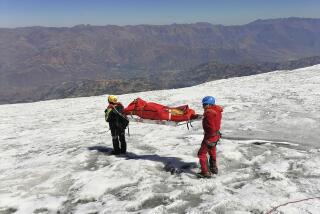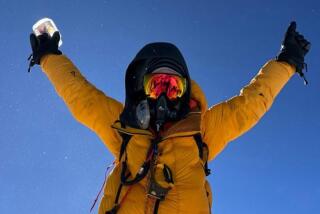Seeing the Real Nepal Through Clouds and Fog
BIRATNAGER, Nepal — It was February, and Katmandu was filled with sturdy-legged trekkers. “When you get to San Diego we’ll show you a good time,” I overheard one American tell a Sherpa during breakfast at Mike’s, the charming garden restaurant where Westerners gather daily for a $2 omelet-and-muffin feast.
It was my final city meal before starting an eight-day trek. I didn’t know it then, but those trekkers were the last I would see until my return to Katmandu. Despite the surging popularity of hiking in the Himalayas, 50,000 of the 54,000 trekkers in Nepal in 1988 headed for just two destinations--the Everest or Annapurna regions.
To avoid the hordes, six writers were joining Steve Conlon, head of Above The Clouds, a Massachusetts-based adventure travel company, to try a new route along a ridge called Milke Danda in eastern Nepal, a region just recently opened to trekkers by the government.
As we flew to the city of Biratnager, from which a bus was to drive us six hours north to our starting point, I could not take my eyes off the thrilling view from the airplane window. Cho-Oyu, Everest, Lhotse, Makalu, Kanchenjunga--the snowy tips of some of the highest peaks on the planet poked through the cloud bank below us.
I had waited 12 years to see these majestic mountains again. In 1978 I had done an exhausting trek. Now my excitement at returning to the Himalayas was tinged with nervousness. Had I trained hard enough? Would I be able to enjoy the views, rather than slog along, panting, my eyes staring down at my boots as I had the time before?
It was night when our bus dropped us off at the end of the paved road. We had climbed from near sea level to 7,000 feet--still the “hills” by Himalayan standards. A row of green tents beckoned. We ate a quick traditional dinner (including daal bhat , the rice dish that is the staple of the Nepalese diet) inside a candle-lit dining tent and crawled into our sleeping bags.
Morning dawned clear and cold. Far in the distance, across row after row of brown hills, we could just make out the tops of Makalu and Everest. I peeked at the itinerary: This day would be “an easy one,” Steve had written, “gentle uphill along the ridge . . . with the Himalayas always before us. . . .” I was so eager for a closer look at the mountains that I hardly noticed how steep the “gentle uphill” was.
But for Nepal it was fairly easy. That’s because the Himalayas are so vertical that they make hiking in the Sierra or Rockies seem like a stroll in Central Park. Nevertheless, my physical fears were unfounded. Smart companies realize that not everyone wants to emulate Sir Edmund Hillary; a growing number of treks require less than two weeks of walking and skirt the vertical climbs via ridge trails.
What’s more, the burgeoning number of adventure travel outfits are competing to lure the experienced trekker back for a second or third Himalayan experience. Thus, unusual routes in out-of-the-way places such as Milke Danda, the primitive Dolpo region and the neighboring country of Bhutan, are showing up in more and more trekking catalogs.
We climbed a rocky but well-worn path bordered by strands of huge rhododendron trees. “In the spring the whole place is red with their blossoms,” remarked Maitalal, a Nepalese friend of Steve’s. But it was not yet spring. Well before our lunch stop, an ominous, clammy fog rolled in, obscuring everything more than three feet in front of us.
And so began what we dubbed our “ In the Clouds” trek. For the next eight days the fog, unusual for February, enveloped the east Nepal Himalayas. It was just our bad luck. October through April is considered prime time, weatherwise. But the January “mini-monsoon,” which causes fog and rain for a few days throughout the country in mid-winter, had arrived late. It seemed as if the mountain gods were pouring pea soup from the heavens. “Now I know why the book about Shangri-La was called ‘Lost Horizon’,” I wrote morosely in my diary.
Each morning I would unzip my tent flap and see only mist, not Makalu. Frost carpeted the trail in the morning. The bushes were coated with rime. Wind-blown ice particles turned tree branches into eerie frozen feathers. At times I felt I could well be in North Dakota, except for the herds of yaks that wandered through our camp at night, the bells around their necks announcing their presence.
For a mountain lover like me it was by turns depressing, surreal and comic. When we got to our campsite, a broad meadow, on Day 4, Steve pointed east, saying, “If it were clear you would see Kanchenjunga (the world’s third-highest mountain) right over there.” We dutifully stared into the blankness.
Then at precisely 2:51 p.m. a patch of blue appeared in the sky. Something white was on the horizon! Was it Kanchenjunga or merely an illusion?
I scurried up the nearest ridge for a better look. Within a minute the fog pulled down the curtain again. Determined to catch whatever tiny glimpses Mother Nature decided to offer me, I perched on a rock, scanning the void. For two solid hours I sat there in a trance, imagining that at any moment Kanchenjunga might appear through the shifting vapors. Perhaps, I thought, I could become a Buddhist and see the mountains with my inner eye.
Somehow, my meditation cheered me up. And as the days passed I learned that visiting an untrekked, unspoiled area could mean more than views.
For one thing, we were not surrounded by other tourists. One friend who had made an Annapurna trek told me that some campsites looked like tent cities. Writer Jeremy Bernstein came across a Mexican restaurant in that area, and he described a town in the Everest region as “crawling with trekkers of every size, shape and nationality.”
Maybe east Nepal soon will be overrun, too. But during our eight days we did not see any other trekking party. Indeed, the only Westerners we met were two anthropologists who were living there.
Because I could not see the scenery I paid attention to the people. And they returned the favor.
Some villages were desperately poor. (Nepal is one of the world’s most poverty-stricken countries.) Barefoot, begrimed, coughing children huddled around smoky fires inside tiny wood shacks, yet their parents were consistently welcoming, always ready to pour us cups of tea. Not a single child tugged at our skirts begging for rupees, as many apparently do in areas more frequented by tourists.
As we descended the ridge we saw classic scenes: water buffaloes pulling crude plows through terraced planting fields, women washing their beautiful long black hair at public water spigots.
We saw bizarre ones, too, such as a barefoot prisoner (we were told he had murdered his mother) shackled to a policeman, being led on foot to the nearest town. At one schoolhouse we visited tiny classrooms where elementary grades children were learning to read. Then classes came to a halt as Steve spoke to the youngsters in Nepali. At another, scores of children gathered around while he pulled a paperback atlas from his pack and showed them where “America” is.
Outside the village of Chainpur we strolled through the weekly market. Rural people, many of them women with elaborate gold rings through their noses, set up shop in an open-air square selling all kinds of goods: huge cakes of brown sugar, tasty tangerines, plastic bracelets. I bought what looked like a grapefruit for 2 rupees (a fraction of a penny), sliced it with my knife and took a bite. Surprise! It was a gigantic, very tart lemon.
At the final campsite our Sherpa cook baked a farewell cake. In whipped egg whites on top was a message: “See you again.” There’s a good chance of that. The most rewarding aspect of the journey was the one I did not train for. Despite the fog this trek gave me a fascinating glimpse into a poor but proud culture.
I had come to see the Himalayas; instead, I saw Nepal.
Getting Here: I flew Lufthansa from New York via Frankfurt to Katmandu, a trip that happily avoids a night layover in the New Delhi airport. Lufthansa, Singapore and Thai International are among the airlines that fly from the West Coast to Katmandu. It is also possible to fly to Bangkok or Hong Kong and make connections to Katmandu.
Documents: U.S. citizens must have a passport plus entry visa ($10), available from the Nepal Embassy. Call (202) 667-4550 for details. Trekkers must have a permit; major trekking companies will obtain one for you.
Companies With Off-the-Beaten-Path Treks in the Himalayas: Above the Clouds Trekking, P.O. Box 398, Worcester, Mass. 01602 (toll-free phone: 800-233-4499) offers two treks in east Nepal, one just north of the Katmandu Valley, another in the Indian Himalaya. It has an office in Katmandu as well as the United States.
InnerAsia Expeditions (Also represents Mountain Travel Nepal), 2627 D Lombard St., San Francisco 94123 (toll-free 800-777-8183) specializes in Bhutan, the Buddhist kingdom east of Nepal. Its affiliate, Mountain Travel Nepal, offers numerous unusual and/or short treks in Nepal.
Overseas Adventure Travel, 349 Broadway, Cambridge, Mass. 02139 (toll-free 800-221-0814) has a short trek in Tibet plus trips through Dolpo, the Ganja-La Pass and other areas of Nepal.
Mountain Travel Inc., 6420 Fairmount Ave., El Cerrito, Calif. 94530 (toll-free 800-227-2384) features several trips in both east and west Nepal, plus Sikkim and Bhutan.
Wilderness Travel, 801 Allston Way, Berkeley, Calif. 94710 (toll-free 800-247-6700) has treks to Dolpo and Kanchenjunga Base Camp.
There are numerous others companies in the United States and Katmandu. It is wise to comparison shop and to get personal recommendations.
Cost: Land costs of treks vary widely, as does length, level of difficulty, amount of luxury provided and other factors. In general, a trip with one of the best-known, American-based outfits runs $50 to $100 a day. Some Katmandu-based outfits charge considerably less. You can also bring your own gear, hire your own porters and guide through small Katmandu agencies, and do an independent trek for as little as $25 a day.
More to Read
Sign up for The Wild
We’ll help you find the best places to hike, bike and run, as well as the perfect silent spots for meditation and yoga.
You may occasionally receive promotional content from the Los Angeles Times.






